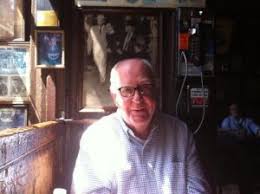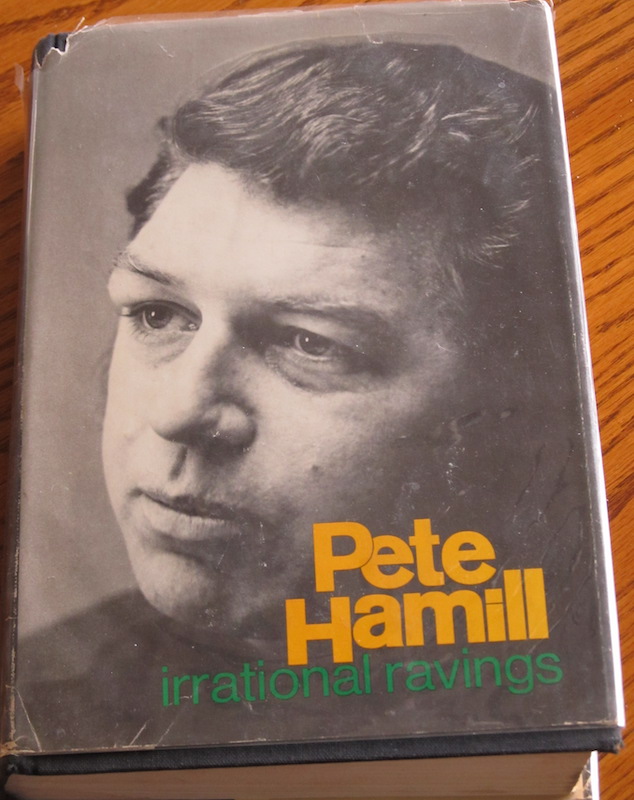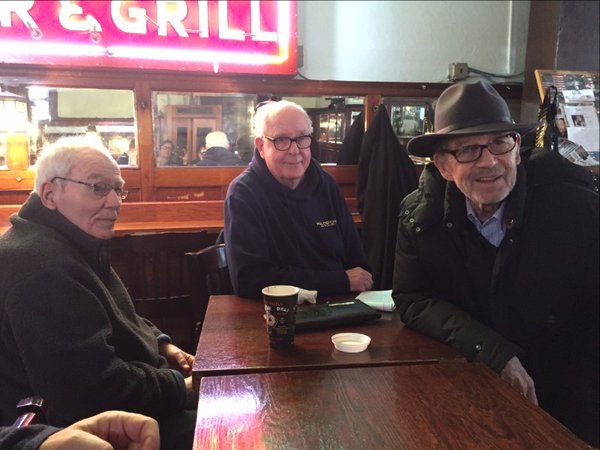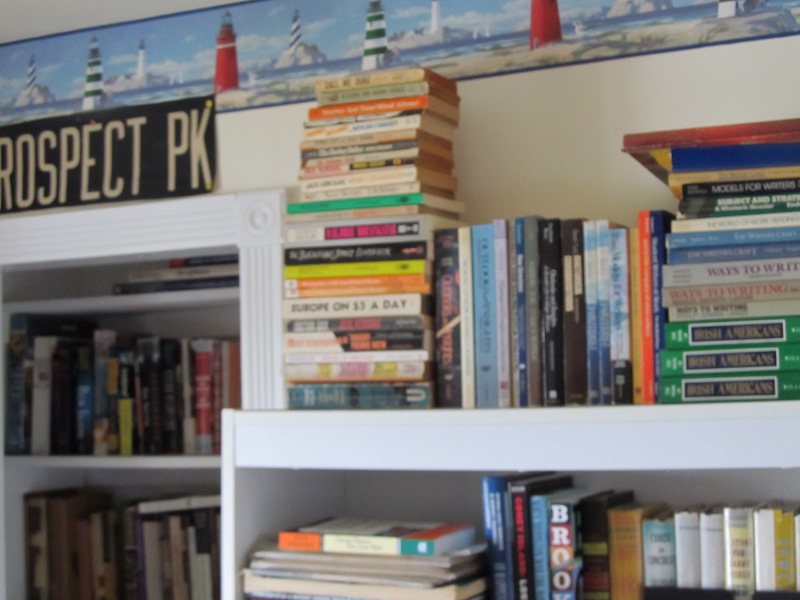
By Pat Fenton
Each day as I watch the news on television I wonder about the book shelves the newscasters use as back drops as many of them broadcast from their homes, newscasters like Anthony Mason from CBS “This Morning” who actually uses some of his books to prop up the make shift lighting for his show, and Maurice Dubois from CBS’ evening news, and Gloria Borger from CNN along with Anderson Cooper.
Books tell so much about who we are, who our heroes are, what our dreams once were when we were young.
My friend Pete Hamill has many of his books separated as neighborhoods. “I call them the tenements,” he once said to me as he pointed to a long hallway that was filled with over a thousand hard covered books, floor to ceiling. “The Irish tenement is over there. Then there’s France, and Italy and Spain.”
As the long days and mornings of the coronavirus confinement drags on, I find myself going back to my book shelves. Aside from the beauty of hard cover books, they still take us to places that are far from the reality of our rooms.
On my shelves is the Celtic beauty of the words of Brendan Behan. As I reread some of them I realize how much the seemingly simple style he uses to describe a fall afternoon as he looks out a train window headed from Dun Laoire to Dublin comes from the style of Hemingway: “I pulled down the window and poked out my head. Though the ground was frosty it was going to be a beautiful day and the sun had taken more heart now and began to shine. I could see familiar houses and people busying themselves with the moments’ of the day and I marveled at the greenness of the fields and the trees in regular rows that seemed to stretch for miles. They had lost their leaves in readiness for winter.”
I’ve been rereading Hemingway’s beautiful “Big Two Hearted River,” and Pete Hamill’s early stories that made me want to be a writer. Perhaps one of the best collections of nonfiction stories that read like the best fiction of Hemingway is Pete Hamill’s “Irrational Ravings.” In it are stories of war, stories of prize fighters, and stories of the girls he knew from the Brooklyn he came out of.
He ends his story “The Neighborhood Girls,” a story about girls from a long ago Park Slope Brooklyn in the 50s, a long ago Windsor Terrace, with the profound line: “There is no moral here; especially from the likes of me. But those people I used to know did at least have an incredibly romantic couple of years when they were young. Maybe it was worth what followed, although I doubt it.”
 On my desk in front of me I have a copy of “Irrational Ravings” and as I flip it open I see a note on the title page he wrote to me so long ago when I was just shaping my own writing style. His brother Brian, a talented photographer, shot the cover for it. In the mid 80’s we appeared on the Barry Gray radio show together and I brought a copy of it with me. We talked for a while before the live show went on the air and I told him how much I liked a piece he wrote about our old neighborhood. It was called “Spaldeen Summers.”
On my desk in front of me I have a copy of “Irrational Ravings” and as I flip it open I see a note on the title page he wrote to me so long ago when I was just shaping my own writing style. His brother Brian, a talented photographer, shot the cover for it. In the mid 80’s we appeared on the Barry Gray radio show together and I brought a copy of it with me. We talked for a while before the live show went on the air and I told him how much I liked a piece he wrote about our old neighborhood. It was called “Spaldeen Summers.”
As we were leaving the studio I asked him to sign my copy of “Irrational Ravings.” He signed it and I didn’t look at it until I was going downtown on the E train. It said: “For Pat Fenton, keep your heart in those Spaldeen Summers. Cheers, Pete Hamill”
We were both so much younger then, but as the days of the coronavirus drag on I realize more than ever, it was good advice then, and it certainly is good advice now.
In the room I write in I have a tall book shelf right behind my desk, and right next to it a closet I converted into rows of books shelves. On those shelves is a literary road map of my life. One of the first books I ever read is on those shelves.
In the classrooms of Holy Name parochial School, beyond the still hallways that ran like a maze through the old Catholic School building that stood on 9th Avenue and Prospect, the only sound the choir like voices of young students reciting in rote a page from the Baltimore Catechism, I learned how to read my first book. It was here where I learned how to dream.
The book was called “This Is Our Town.” It was about a small town called Timber Town and the families who lived in it. It was illustrated by an artist called Charlotte C. Ware. I didn’t know then, and I still don’t know who she was, but her illustrations were so alive with color you wanted to cut them out and frame them.
One of them showed a group of young boys looking down from a high hill on their town, and off in the distance you can see a factory with smoke coming out of a row of tall chimneys. And it could have been a description of Windsor Terrace in the 40s with rows of factories around the corner from 17th Street where I grew up; factories I would one day go off and work in as a young man.
And some years ago, as if it was meant to be, I actually saw a copy of “This is Our Town” on the book shelf of an old book store. The copyright on it was 1941. Just holding it in my hand brought me back to Holy Name; brought me back to the old cloak rooms I once dutifully filed through. There was a heavy black wire screen separating the classroom on the other side. You were not allowed to speak to anyone from the other classroom as you hung up your jacket. In total silence, you filed through one door and out the other.
In these days of trouble and strife as we get through the blow the coronavirus has delivered to our country I find myself going back to books. And I think a lot of other people are too. I’m a writer and I never left them, but now I find myself going back to books that I grew up with, books that guided me and self-educated me. In the 50s, like a lot of young men from my working-class neighborhood, I dropped out of Manuel Training High School in South Brooklyn at 16, but the books were still there.
I pushed garment racks through the noise of the crowded streets of the Garment District, worked the afternoon shifts in the factories of the Red Hook waterfront, places like Bush Terminal and Industry City. But on weekends I traveled to Greenwich Village to places like the 8th Street Book Store to buy books.
I never sat in formal university classrooms where professors would ask me questions as they taught me what the book’s authors meant. I knew what they meant to me. Books are their own teachers.
So these books are who I am. Now as I watch the nightly news I wonder who the people sitting in front of the book cases in their living rooms are. It’s something I never thought about before. It’s like they have broken the fourth wall of theatre, an imaginary barrier that separates the audience from the actors and reality.
I find myself bending over sideways to try to read some of the titles on their book shelves. I wonder, if like me, did they ever read J.D. Salinger’s “Nine Stories,” or “Franny and Zooey?” It would tell us so much about who they are.
Did they ever read Jack Kerouac’s “The Town and the City” or James Thurber’s “The Thurber Carnival” or James Jones’ “Some Came Running?” Did they ever read “A Stone for Danny Fisher” or Alan Sillitoes’s “The Loneliness of the Long Distance Runner,” or his “Saturday Night and Sunday Morning”? Did they ever read Bob Greene’s “Chevrolet Summers, Dairy Queen Nights”, or Oscar Hijuelos’ “The Mambo Kings Play Songs of Love?”
Had they read Jimmy Breslin’s “World Without End Amen”, or Alfred Kazin’s wonderful book “A Walker in the City” about growing up Jewish in the tough streets of Brownsville Brooklyn, or the “Amboy Dukes” by Irving Shulman, or Pete Hamill’s, “The Gift?”
I’m not sure why, but it would comfort me during these times if I saw some of those books on their shelves.



Pat,
I’m a Windsor Terrace girl and loved your post. I too have been turning my head sideways to spy the books behind the journalists. We have a lot in common, perhaps when we come through this we can meet for a pint! Or we can do via Zoom and I can spy your bookshelf. Stay well, healthy and safe and keep reading those touchstone classics.
Your fellow Brooklynite,
Claudia
Thank you for your kind words, Claudia . Always glad to hear from someone from Windsor Terrace. see you around Farrell’s when all this winds down.
Pat
When I was a kid in Park Slope, I went at least once a week to the library @ Grand Army Plaza, I went there in search of a specific book or magazine article, but would always get distracted. Three hours later after reading books and magazines that I wasn’t there to read, I would get what I went there for & bring it home. I sure learned a lot reading about things I would have never read if I wasn’t @ the library. 60 years later, I still go to libraries & get distracted.
That was a great library, Bob. we were lucky to have it in our neighborhood. I also, often, went to the one on 6th Avenue and 9th Street.
Pat